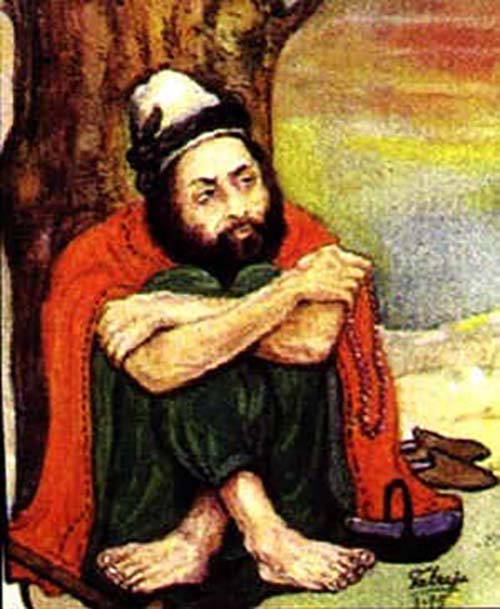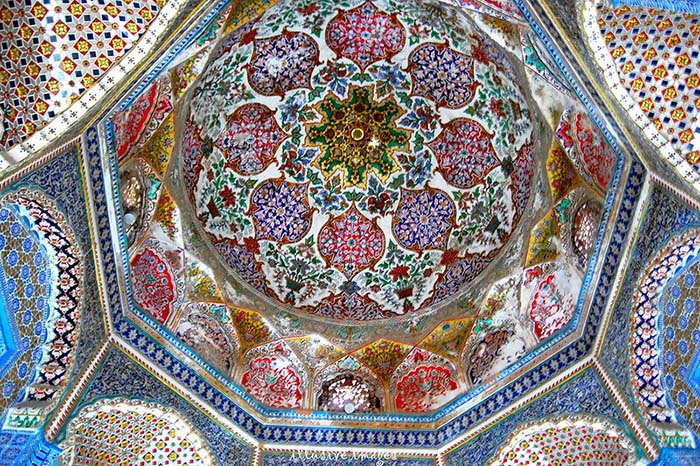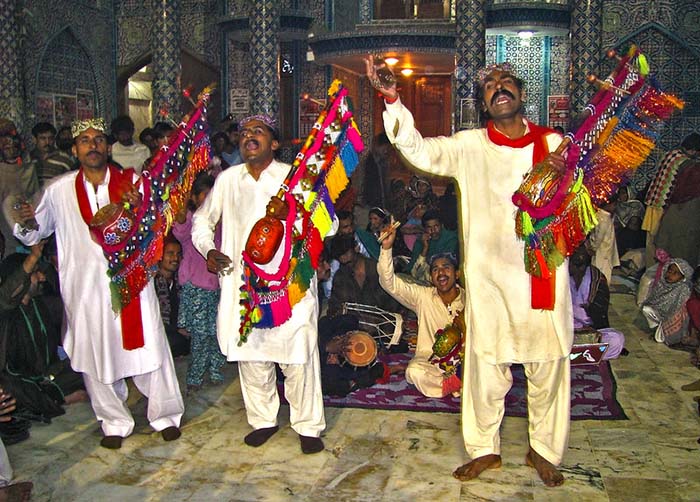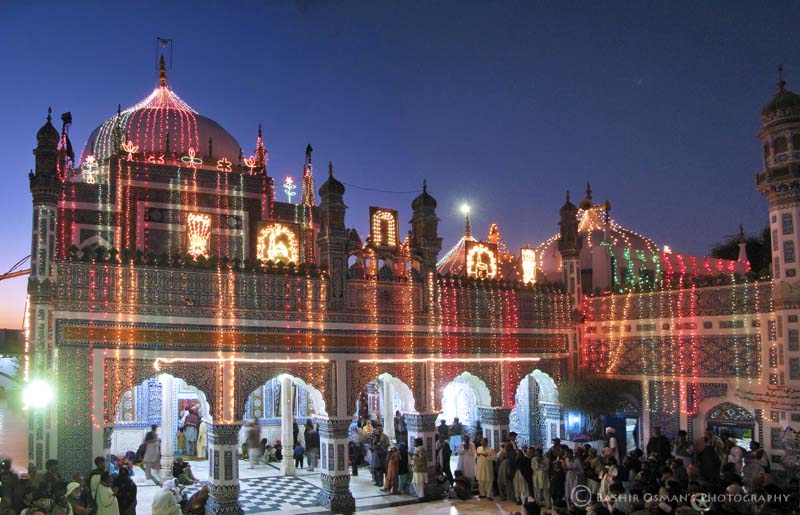[ad_1]
Written by: Mahnaz Shujrah
Posted on: March 31, 2020 | 
Entrance to the Shrine (photo credit to the writer)
The subcontinent is generally divided into two major regions, based on the literature dating back to the first Arab conquests. The land East of the Indus river was referred to as “al-Hind”, and the area on the West, “al-Sind”. Throughout history, Sindh has been a geographically strategic area, and the center of the Great Indus Valley civilization. Over centuries it has witnessed countless rulers, religions and languages. From within this ethnic mosaic emerged a strong folk culture and the Sindhi language, rooted deep within the soil of the land.
A prominent feature of Sindhi culture is the traditional following of saints and shrines. One of the most popular shrines in Sindh today is located in Bhit Shah, the final resting place of the famous Sindhi Sufi poet Shah Abdul Latif Bhittai (1689-1752). His father, Shah Habib, a descendent of a notable poet Abdul Karim of Bulri, is said to have migrated from Afghanistan in search of spiritual knowledge. He settled near Hala in Sindh where Shah Latif was born, close to the Indus River.
Shah Latif was believed to have an observant and inquisitive personality. He was fluent in many languages, knowledgeable about the Quran and other religious texts, and went on frequent excursions to surrounding areas. One of his favorite places to sit and meditate was a great sand mound, Bhit, not too far from his home. He would spend hours pondering over philosophical questions, and became well acquainted with the local musicians who wandered the desert. Shah Latif’s beloved father was buried on that mound when he passed away, and Shah Latif is buried just a few meters in the same complex. The town which erupted around the shrine is known as Bhit Shah.
The construction of the shrine took place in 1772 during the rule of Ghulam Shah Kalhoro. Shrines are often constructed by followers or devotees, but the story of this shrine is indeed unexpected. It is said that during much of Shah Latif’s life, Mian Noor Muhammad Kalhoro was the ruler. Kalhoro was not on good terms with Shah Latif’s family, and was not particularly fond of the poet either. Well aware of his simple and humble personality, Kalhoro invited him to an extravagant royal event, with dancing women, in order to publically embarrass the mystic. One dancing girl in particular was given the task to entice the Sufi poet.
While everyone else was offering gold coins, Shah Latif had no money to offer. He told the girl he could give her nothing but a prayer (dua) that one day she would give birth to the ruler of Sindh. As fate would have it, this girl named Mai Gulan became the wife of Noor Muhammad Kalhoro, and gave birth to their son, Ghulam Shah Kalhoro, who became a devout follower of Shah Latif. This account is not verified but it is well known amongst locals and Sindhi families as oral heritage.
The tomb is decorated with beautiful blue and turquoise title work called kashi kari, a technique native to Iran and later adopted widely throughout the subcontinent. Generally, shrines come under the authority of gaddi nasheens, descendants of Sufi disciples, who are often local landowners. Gaddi nasheen tend to wield a strong influence over the region, and their presence plays an important role during rituals and ceremonies.
In the case of Bhit Shah, fakeers are also important stakeholders. They are motivated by their religious fervor and they actively and continuously promote Shah Latif Bhittai’s work. There are several types of fakeers, each with distinct roles and duties. Most of them belong to a less privileged background, and they live around the shrine complex.
For 300 years these two groups have been responsible for the activities of the shrine. However, since 1960, the primary control of the shrine belongs to Auqaf Department, a governmental department which overlooks the financial and structural aspects at the provincial level. This is also why it was recently closed under strict orders of the government to prevent gatherings at shrines, for fear of the spread of Coronavirus in Sindh.
Shah Latif Bhittai was a contemporary of other iconic Punjabi Sufi poets, including Bulleh Shah and Waris Shah, both of who’s shrines are located in Punjab. Bhittai and other Sufi poets deliberately chose to express themselves in the vernacular languages, in order to communicate effectively with the ordinary people. This is why their message is still remembered, recited and adapted by modern day followers.
Bhittai’s final work is compiled in Shah Jo Risalo. What makes the tomb of Bhittai even more unique is the gathering of Raagi Faakirs as they perform Shah jo Raag, accompanied by the tambura, an instrument, which some say was perfected by Bhittai himself. These ritual performances occur at designated times of the day, and several specific rituals happen on certain days of the week. The most important event of the year is the Urs of Bhittai, during which the entire town comes alive and goes for hazari (attendance) at the shrine. Bhit Shah Mela (festival) is also a relatively new initiative, to promote cultural events, local languages and musical knowledge, along with arts and crafts activities for children.
After traveling through many remote parts of Pakistan and exploring diverse cultural sites, there is something distinctly special about Sufi shrines. They are living spaces which have shaped the society around them. The different aspects come together to function as one living, breathing organism. Each time I have visited Bhit Shah, I came across devotees and visitors of all ages, socio-economic backgrounds, religions and ethnicities. There are many women at many of the shrines, but the strict gender division are changing the dynamics within the boundary of the complex.
Today there are many translations and research on the work and life of the great scholar, poet and philosopher Bhittai. As a cultural enthusiast, it is fascinating to visit and discover the legacy left behind by the great Sufis who have shaped the local culture, and contributed to how religion is practiced within the Subcontinent.
For more information on Shah Abdul Latif Bhittai’s work, click here.
You may also like:
[ad_2]
Source link






